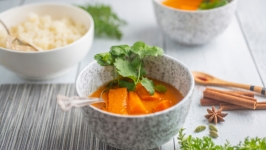Bourbon Steak’s Housemade Salt
A pinch of local flavor
Salt. A fundamental element , a mineral, a seasoning—an ingredient in almost every recipe. “It’s something you use every day without thinking about it,” says Steve Gotham, executive chef at Bourbon Steak, Michael Mina’s recently opened outpost in Santa Clara’s Levi’s Stadium.
For Chef Gotham, that everyday ingredient became an opportunity to create the ultimate nature-to-table product. Starting with local seawater, Gotham makes a salt that is used to finish a wide variety of dishes on the restaurant’s modern steakhouse menu. “It’s a connection to the community,” he says, referencing the proximity to the Pacific Ocean and the rich resources it provides.
Every two months, local fishermen bring a 12-gallon bucket of seawater to the restaurant. It is simmered slowly at 160° in an oversized stockpot on a stove top. Once it turns into slush, it is spread into a shallow, rectangular tray where it continues to dry—and absorb the scents of the kitchen environment, which includes a hardwood-fired, open-air grill.
The result? A soft gray, coarsely grained salt that retains the flavors of the ocean while taking on the smokiness of the grill. When piled into a small wooden ramekin, it almost looks like melted snow, with a texture that is still slightly moist from its seawater origin.
Gotham’s single-batch, specifically sourced approach makes his finishing salt more of an ingredient than a seasoning. Since it takes 12 gallons of water to produce two quarts of salt, the small end amount is treated like gold—reserved for finishing some of the restaurant’s most popular, signature dishes. From the Tomahawk bone-in rib eye, to the whole Branzino and a meaty cauliflower steak, the handcrafted salt adds flavor, texture and that final “ta-da!” bringing diners back for another bite.
Gotham learned the salt-making craft while working in Carmel Valley at the Bernardus Lodge. There, local abalone fisherman simmered pots of seawater to a briny slush to create a “Big Sur” salt—a product unique to Monterey Bay. Bringing it closer to Santa Clara, Gotham’s most recent batch of salt bears the handprint of the halibut fishermen who scooped up the seawater on a recent outing off the San Francisco Bay. The location and time of year can make subtle differences in the salt, affecting both the salinity and flavor.
Artisanal salts are becoming more common—and coveted. According to Gotham, finishing salts are typically unfiltered, have high salinity levels and can vary widely in granularity and saltiness—but once a kitchen masters the balance, a pinch can add a nuanced flavor that speaks of the salt’s provenance.
For Gotham, his labor of love delivers a local product and an elevated food experience.




